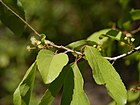Note: This is a project under development. The articles on this wiki are just being initiated and broadly incomplete. You can Help creating new pages.
Difference between revisions of "Flacourita indica"
(→References) |
|||
| Line 5: | Line 5: | ||
===Food=== | ===Food=== | ||
| − | Flacourita indica can be used in Food. Ripe fruits are eaten raw | + | Flacourita indica can be used in Food. Ripe fruits are eaten raw<ref name |
==Parts Used== | ==Parts Used== | ||
| Line 76: | Line 76: | ||
<ref name="How to plant/cultivate">[http://tropical.theferns.info/viewtropical.php?id=Flacourtia+indica Cultivation]</ref> | <ref name="How to plant/cultivate">[http://tropical.theferns.info/viewtropical.php?id=Flacourtia+indica Cultivation]</ref> | ||
<ref name="Uses">Indian Medicinal Plants by C.P.Khare</ref> | <ref name="Uses">Indian Medicinal Plants by C.P.Khare</ref> | ||
| − | <ref name="Nutritional components">"Forest food for Northern region of Western Ghats" by Dr. Mandar N. Datar and Dr. Anuradha S. Upadhye, Published by Maharashtra Association for the Cultivation of Science (MACS) Agharkar Research Institute, Gopal Ganesh Agarkar Road, Pune | + | <ref name="Nutritional components">"Forest food for Northern region of Western Ghats" by Dr. Mandar N. Datar and Dr. Anuradha S. Upadhye, Published by Maharashtra Association for the Cultivation of Science (MACS) Agharkar Research Institute, Gopal Ganesh Agarkar Road, Pune</ref> |
</references> | </references> | ||
Revision as of 14:53, 21 October 2021
Flacourita indica is a slow-growing, ornamental, spiny evergreen shrub or tree. It can reach a height of 10 metres, but is usually smaller. The tree is cultivated in some areas of the tropics, particularly in Asia, for its edible fruit.
Contents
Uses
Fever, Diarrhoea, Inflammations, Asthma, Gynaecological complaints, Hydrocele, Pneumonia, Intestinal worms, Snake bites, Kidney complaints, Hoarseness.[1]
Food
Flacourita indica can be used in Food. Ripe fruits are eaten rawCite error: The opening <ref> tag is malformed or has a bad name
Common names
| Language | Common name |
|---|---|
| Kannada | |
| Hindi | |
| Malayalam | |
| Tamil | |
| Telugu | |
| Marathi | |
| Gujarathi | |
| Punjabi | |
| Kashmiri | |
| Sanskrit | |
| English |
Properties
Reference: Dravya - Substance, Rasa - Taste, Guna - Qualities, Veerya - Potency, Vipaka - Post-digesion effect, Karma - Pharmacological activity, Prabhava - Therepeutics.
Dravya
Rasa
Guna
Veerya
Vipaka
Karma
Prabhava
Nutritional components
Flacourita indica Contains the Following nutritional components like - Vitamin-A, C, Niacin (B3), Thiamine (B1), Ribofl avin; Calcium, Iron, Magnesium, Manganese, Phosphorus, Potassium, Sodium[2]
Habit
Identification
Leaf
| Kind | Shape | Feature |
|---|---|---|
Flower
| Type | Size | Color and composition | Stamen | More information |
|---|---|---|---|---|
| {{{5}}} |
Fruit
| Type | Size | Mass | Appearance | Seeds | More information |
|---|---|---|---|---|---|
Other features
List of Ayurvedic medicine in which the herb is used
Where to get the saplings
Mode of Propagation
Cultivation Details
A very adaptable plant, it grows in the drier to moist tropics from sea level to an elevation of 2,400 metres. Flacourita indica is available through January-July[4]
Commonly seen growing in areas
Dry deciduous forest, Thorn forests, Dry forest, Woodland, Bushland, Wooded grassland, Thickets.
Photo Gallery
References
- ↑ Indian Medicinal Plants by C.P.Khare
- ↑ "Forest food for Northern region of Western Ghats" by Dr. Mandar N. Datar and Dr. Anuradha S. Upadhye, Published by Maharashtra Association for the Cultivation of Science (MACS) Agharkar Research Institute, Gopal Ganesh Agarkar Road, Pune
- ↑ [Morphology]
- ↑ Cultivation
Cite error: <ref> tag with name "chemical composition" defined in <references> is not used in prior text.
External Links
- Pages with reference errors
- Ayurvedic Herbs known to be helpful to treat Fever
- Ayurvedic Herbs known to be helpful to treat Diarrhoea
- Ayurvedic Herbs known to be helpful to treat Inflammations
- Ayurvedic Herbs known to be helpful to treat Asthma
- Ayurvedic Herbs known to be helpful to treat Gynaecological complaints
- Ayurvedic Herbs known to be helpful to treat Hydrocele
- Ayurvedic Herbs known to be helpful to treat Pneumonia
- Ayurvedic Herbs known to be helpful to treat Intestinal worms
- Ayurvedic Herbs known to be helpful to treat Snake bites
- Ayurvedic Herbs known to be helpful to treat Kidney complaints
- Ayurvedic Herbs known to be helpful to treat Hoarseness
- Habit - Deciduous tree
- Index of Plants which can be propagated by Seed
- Index of Plants which can be propagated by Layering
- Index of Plants which can be propagated by Grafting
- Herbs that are commonly seen in the region of Dry deciduous forest
- Herbs that are commonly seen in the region of Thorn forests
- Herbs that are commonly seen in the region of Dry forest
- Herbs that are commonly seen in the region of Woodland
- Herbs that are commonly seen in the region of Bushland
- Herbs that are commonly seen in the region of Wooded grassland
- Herbs that are commonly seen in the region of Thickets
- Herbs
- Pages without herbs images




